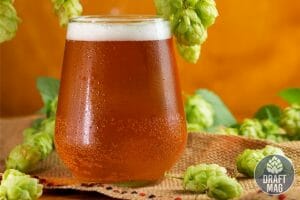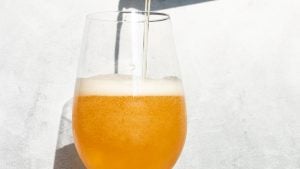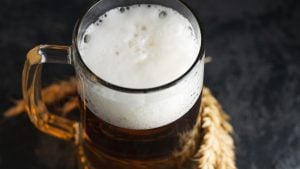Hefeweizen Beer Recipe: The German Wheat Beer Everyone Talks About
 This is the only Hefeweizen beer recipe you wished you had tried earlier. The kind of beer that tastes as good as it looks. It is so beautiful that you just can’t help but brew one for yourself already.
This is the only Hefeweizen beer recipe you wished you had tried earlier. The kind of beer that tastes as good as it looks. It is so beautiful that you just can’t help but brew one for yourself already.
This German wheat beer is everything you are looking for if you are an easy-breezy drinker. It is light, low on bitterness and hop quantities, has clove-like features, and is low on alcohol content as well, which makes it an easy drink.
A Quick Peek Into the History of German Hefeweizen
Mankind has known and brewed wheat beer for as long as brewing has existed. In the 16th century, the Europeans experienced a high rate of inflation. As prices hiked past the bar graph, people tried keeping rye and wheat outside brewhouses, afraid that not enough would be left to bake bread and they would go hungry.
The only exception was the House of Degenberg, in Schwarzach, the only one who had the privilege to brew German wheat beer. Fast forward to the present day, and session beers are an absolute rage. Sure, IPAs and stouts have their place, and can never be substituted, but homebrewers are all over the place about easy recipes, experimentation and discoveries.
– An Overview of Hefenweizen’s Characteristics
This German wheat beer, also known as Hefeweizen, weissbier, and Weizenbier, is an extremely satisfying session beer. The german Hefeweizen is a type of wheat beer from Bavaria, Germany. The term “hefe” means “yeast” in German and “weizen” means “wheat”. So, Hefeweizen technically means an unfiltered wheat beer with yeast in it.
The pouring is cloudy, golden colored with a thick foamy head. With side features of clove, banana, black pepper, and even bubblegum, this is an overall refreshing beer that is easy to drink. This beer contains about 50-60 percent wheat in the mash, making it one of the most protein-rich beers. The wheat percent also defines the distinctly thick head of the beer.
John Trogner, Co-Founder and Brewmaster at Troegs Independent Brewing says, “If you hit fifty to 60 percent wheat, you are 99 percent there.” Whether you are drinking on a hot summer day or by the firepit, this can be your go-to beer.
– Characteristics of a Hefeweizen Beer
| Color Range | 2.6 SPM |
| Final Gravity | 1.01 – 1.014 FG |
| IBU Range | 8 – 15 IBUs |
| ABV Range | 4.8 – 5.5 % |
| Appearance | Deep gold, lasting white head, cloudy |
| Aroma | Little malt and hop character. Citrus, Vanilla |
| Flavor | Clove and banana, small notes of vanilla and bubblegum |
| Mouthfeel | Medium body, medium light, High in wheat proteins, and effervescent |
How To Brew a Hefeweizen: Follow These Simple Steps
For most homebrewers, the authentic definition of a Hefeweizen beer translates into a yeast dominant beer with a good range of cloves, with a punch of banana by the side. This way, the flavors can support each other. There is a reason why this variety of beer is primarily yeast dominant – its distinct flavors all come from the yeast.
While the Americans call this beer the Hefeweizen, the Germans have it named “Weizenbier” which literally means “wheat beer”. At an alcohol percent range of 4.8 to 5.5, the Hefeweizen is a bit higher than some other homebrews. Typically, the Hefeweizen alcohol content is strong enough to complement its distinct flavors, but light enough to be enjoyed on a midsummer day or a cool winter night.
On the other hand, the prime quality of this beer is that it is unfiltered. The flavors are a distinct result of the suspended yeast. The yeast strains also produce slight fruity esters that highlight banana-like and bubblegum-like flavors. That said, here is the easiest recipe you will ever find on brewing the German Hefeweizen.
– Tools and Equipment Needed for the Brew
- 5-gallon brewer pot
- Fermenter bucket
- Stainless steel spoon
- Timer
- Hygrometer to measure gravity
- Wort chiller
- Bottles
- Bottling bucket
- Siphoning tubes
- Stovetop
– Hefeweizen Beer Recipe for Easy Hefeweizen Brewing
These are the Hefeweizen ingredients we will be using to brew the german wheat beer:
- 25 oz Hallertau (hops)
- 6 lb liquid wheat malt
- 1 lb wheat dry malt extract
- 12 Danster Munich wheat beer (yeast)
- 7-10 oz corn starch (for priming)
– An Eight-step Guide To Brewing a Hefeweizen Beer
-
Preparing the Malt Mash
 The first step in brewing any beer is preparing the malt. This means, mixing malt with water and boiling the mixture. This initial step, if done right, helps extract the right flavors from wheat grains.
The first step in brewing any beer is preparing the malt. This means, mixing malt with water and boiling the mixture. This initial step, if done right, helps extract the right flavors from wheat grains.
In this recipe, wheat malt extract is used instead of actual wheat grains. Extracts are pre-made grains. It saves the process of milling your grains. This is easier if you are new to brewing and might go wrong in the milling process.
For the malt, fill your brew pot with clean water. Place it on a stovetop and bring it to boil. Add half the liquid wheat malt, turn the heat off and thoroughly stir the wheat malt in. This mixture is called the wort which is now going to be ready for the fermenting process.
-
Add Hops to the Malt
Hops bring in the bitter characteristics in a beer. Higher the hops, more the bitterness. There are many hops to choose from. But for this particular beer, we will use lesser bitter hops with a low alpha acid content. The bitterness here is minimum to maintain a good balance between the bitterness and the fruity flavors of the beer.
Here, we choose the Hallertau hops. It comes from Hallertau, Germany. The flavors are mildly floral and citrusy.
Turn the stovetop on and add the hops. Set a timer for 60 minutes. 45 minutes into the boil, pour dry wheat malt extract and the remaining liquid malt. Boil the wort, malt, and hops together for the last 15 minutes.
-
Cooling the Wort
The temperatures in the brewing process matter most. Take the wort off the stovetop and cool it down to 45-55 degrees Fahrenheit. Using a wort chiller is best, but if you don’t have one handy, you can always fill the sink with ice-cold water and keep the pot in it. It is like giving the wort its own ice bath in the kitchen sink.
Maintaining the temperature is important at this point as the next step is to pitch the yeast into the wort to start the fermentation process.
-
Sanitize the Equipment in Use
While the wort is chilling (this will take time), you can move over to cleaning and sanitizing all the equipment you will be needing from this point forward. Everything you use in the fermenting process should be cleaned and sanitized to get off any microbes. The fermenting bucket, spoon, siphoning equipment, caps, bottles, stoppers, etc.
-
Increase the Volume of the Wort.
It is always a good practice to increase the volume of the wort. The higher the wort, the better the result.
Add 2 gallons of cold water to the fermenter bucket. And transfer the cool wort into the same bucket. Measure the gravity of the wort using a hydrometer.
-
Pitching Yeast.
This step is the most important in the entire process. Especially when we talk about German wheat beer. But before adding the yeast, aerate the wort. Then cut the packet of yeast with clean sanitized scissors and pour the yeast into the solution. Put a lid on the container and lock the bucket.
-
The Hefeweizen Fermentation Process
After adding yeast, move the bucket to a warm, dry place, away from direct sunlight, and allow the fermentation process to take place. The ideal temperature range we are looking at here is 65 to 75 degrees Fahrenheit.
In this process, the yeast will ferment the wort and break it into carbon dioxide and alcohol. Store the container for up to two weeks aside in a cool dark place. Once fermentation is over the foam that forms over the beer, bubbling will stop and the beer will gravitate more. Now the beer is ready to be consumed.
-
Bottling the Beer
If you have come this far, you are now done. Excellent work here. Your Hefeweizen is now ready to drink. The final step is bottling the beer. Start with sanitizing the bottle, cap, and bottling equipment.
One last step right before bottling is to add cornstarch for carbonation. Add ½ cup corn sugar to water and bring to a boil. Cool the solution and then add it to the bottling bucket. This step is important, as carbonation gives the beer its final tangy, crispy mouthfeel.
Stir the solution into the bucket evenly. Finally, use the siphoning equipment to transfer the beer into the bottling bucket to mix it with the solution. Finally, pour the beer into the bottles, and refrigerate it before drinking.
– Extra Tips: Some Expert Tips That Come in Handy While Brewing
You can always invest in a starter kit for your Hefeweizen beer. The kit comes with the necessary equipment, ingredients, hops, and yeast. It is a simpler solution for beginner homebrewers.
- Read the direction given on your yeast packet and follow them correctly. The temperature, stir quality, matter for the ideal final product.
- This beer is meant to be consumed young and fresh.
- Your Hefeweizen water profile should be of a Ph range between 5.2 to 5.6
– Hops for Hefeweizen: These Are the Hops Options You Can Use
There are many hop options available for a Hefeweizen brew. Since this is a German wheat beer, it is best advised to use German hops like:
- Hallertau
- Magnum
- Perle
- Tettnang.
As a substitute, Liberty or mount hood can work. There should be a good balance between the hop bitterness and sweetness. It is best to target an IBU range of below 12 to crack the right balance.
FAQ
What’s the difference between American Hefeweizen and German Hefeweizen?
American Hefeweizen is typically lighter in color and body, with less yeast character than its German counterpart. German Hefeweizen is known for its distinct banana and clove flavors.
How long does it take for Hefeweizen to ferment?
Hefeweizen typically takes around 1-2 weeks to ferment, depending on factors like temperature and yeast strain.
What is the best mash temperature for Hefeweizen?
The ideal mash temperature for Hefeweizen is around 149-158°F (65-70°C) to achieve a balance of fermentable and unfermentable sugars.
Conclusion
 The classic combinations of wheat barley and yeast bring in the prominent flavors of a Hefeweizen beer. It typically pours pale, golden yellow with a long-lasting head. The dominant flavors are banana, clove, vanilla, and a tinge of bubblegum. The high carbonation levels are one of the reasons why this beer is a refreshing summer drink.
The classic combinations of wheat barley and yeast bring in the prominent flavors of a Hefeweizen beer. It typically pours pale, golden yellow with a long-lasting head. The dominant flavors are banana, clove, vanilla, and a tinge of bubblegum. The high carbonation levels are one of the reasons why this beer is a refreshing summer drink.
While a Belgian-style witbier gets its characteristic citrus and spice flavors from a physical addition of orange or coriander, there are no adjuncts added to a Hefeweizen. This is the perfect drink to chill with by the fire and on a hot summer day too. Brew your Hefeweizen now!






